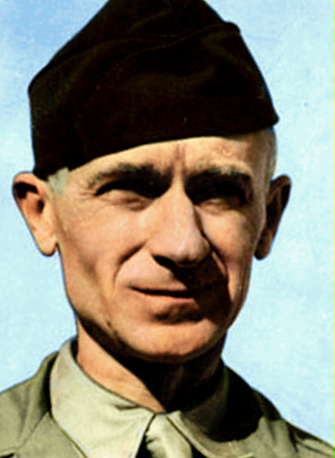
Roving Reporter
By Ernie Pyle
OKINAWA (By Navy radio) – Now that we are ashore im full force upon the Japanese island of Okinawa I would like to go back and tell you in detail how the invasion went off.
As our regimental commander said the night before the landing:
All I’m worried about is getting past the first two days when we are on our own and will have to improvise to meet every situation. But after that we will be established and from then on, we can just go by the book.
The first two days are over – accomplished with an ease that had everybody flabbergasted. By evening of the first day, we had done much more than the most optimistic planner figured we could in the first three days. So from now on it’s “By the Book.”
For some reason which I haven’t fathomed yet the conventional name of D-Day was changed for this invasion to “Love Day.” Possibly it was because we were landing on Easter Sunday and somebody felt the spirit of brotherly love.
At any rate when dawn came on Love Day and the pink, rising sun lifted the shroud of oriental darkness around us, we were absolutely appalled.
An all-out job
For all our main convoys had converged and there they lay around us in one gigantic fleet, stretching for miles. There were around 1,500 ships and thousands of small landing craft which the ships had carried with them.
There weren’t as many small ships as at Normandy, but in naval power and actual force of men and fighting strength it was equally as big as the invasion of Europe. We certainly didn’t go at Okinawa in any half-hearted manner.
We had ham and eggs for breakfast at 4:30 a.m. We strapped our unwieldly packs on our backs. Our heavier gear was left aboard to be taken ashore several days later.
It was only half-light when we went on deck. You could see flame flashes on the horizon toward shore. The men on the deck were dark and indistinguishable forms.
This was IT
Our assault transport carried many landing craft (LCVPs) on desk. They were lifted by a derrick and swung over the side. We piled into them as they hung even with the rail. Then the winch lowered them into the water.
I went on the first boat to leave our ship. It was just breaking dawn when we left. It was still more than two hours before H-Hour. Our long ocean trip was over. The days we had reluctantly counted off were all gone. Our time had run out. This was it.
All around us hundreds of other boats were putting off and churning the water, but there was no organization to it. They weren’t yet forming into waves. These early boats carried mainly the control crews who would manage the colossal traffic of shore-bound invasionists in the next few hours.
We chugged shoreward for more than an hour, for we had stopped far offshore. Our destination was a small control ship lying about two miles from the beach.
Easy to get lost
Scores of these little control craft were forming a line the entire length of our long beachhead, about a quarter of a mile apart. They were the traffic policemen of our invasion.
They all looked alike, and we had to find ours by number. In all the welter of mules of ocean traffic. It was easy to get lost and we did. We were half an hour finding our control boat after getting there.
An assault on an enemy shore is a highly organized thing. It is so intricately organized, so abundant in fine detail that it would be impossible to clarify it all in your mind. No single man in our armed forces knows everything about an invasion.
But just to simplify one point–
Suppose we were invading an enemy beach on a four-mile front. It is not as you would think, one over-all invasion. Instead, it is a dozen or more little invasions, simultaneously and side by side. Each team runs its own invasion. A combat team is a regiment. Our regimental commander and his staff were on the little control ship. Thus, our control ship directed only the troops of our regiment.
We had beaches “Yellow One” and “Yellow Two.” Troops of our regiment formed waves directly off those beaches, miles at sea, and we went straight in.
Other control ships on either side, having nothing to do with us, directed other waves having nothing to do with us. Each was its own private little show.
As I’ve written before, war to an individual is hardly ever bigger than a hundred yards on each side of him. And that’s the way it was with us at Okinawa.
